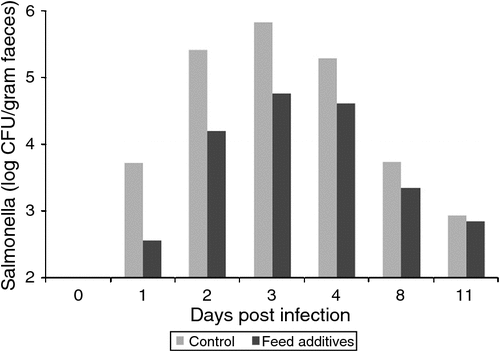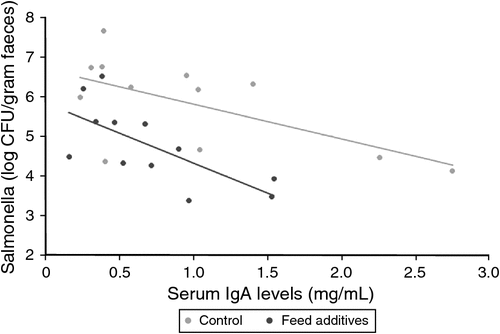Novel feed additives controlling Salmonella typhimurium in pigs
J. Allaart A B , C. Silva A , M. van der Heijden A and P. Roubos-van den Hil AA Trouw Nutrition R&D, Amersfoort, 3800 AG.
B Corresponding author. Email: j.allaart@trouwnutrition.com
Animal Production Science 57(12) 2496-2496 https://doi.org/10.1071/ANv57n12Ab037
Published: 20 November 2017
Non-typhoidal salmonellosis is estimated to cause 93.8 million cases of acute gastroenteritis and 155 000 deaths globally each year, ~85% of which are estimated to be foodborne. Pork products are among the top food-borne sources of salmonellosis globally (FAO/WHO 2016). Reduction of contamination in the feed-to-food chain is necessary to reduce the number of human cases. Since antimicrobial resistance is on the rise, there is an urgent need for new antibacterial strategies to reduce salmonellosis. This paper investigates antibacterial properties of a mixture of organic acids (formic and lactic acid) with two novel feed additives: mannanase-hydrolysed copra meal (CM) and rye overgrown with mycelium of Agaricus subrufescens (ROM) using a porcine Salmonella typhimurium infection model. Formic and lactic acid were included because of their antibacterial properties (van Immerseel et al. 2006), while the other components were supposed to reach the intestinal tract where they may competitively bind to S. typhimurium. Furthermore, mannanase-hydrolysed copra meal contains β1–4 mannobiose, which may increase IgA-response and reduce S. typhimurium shedding after infection (Agunos et al. 2007).
In vivo activity of the feed additive blend was evaluated in a S. typhimurium challenge study with 24 piglets individually housed directly after weaning. Piglets were fed a control diet or the same diet supplemented with the combination of organic acids, CM and ROM. To provide the disease challenge, piglets received feed containing109 CFU S. typhimurium from 5 days after weaning for seven consecutive days. The pigs were monitored for S. typhimurium shedding and serum immunoglobulin A (IgA) (3 days post infection). Data were analysed using the GLM procedure (SAS v9.4, SAS Institute Inc., Cary, NC, USA).
In all treatment groups S. typhimurium infection resulted in a mild increase in body temperature (<0.5°C), mild diarrhoea. The combination of feed additives significantly decreased S. typhimurium peak shedding during the first week after infection (4.0 ± 0.27 v. 5.1 ± 0.27 log CFU/gram faeces; P < 0.01; Fig. 1). Immunoglobulin A serum levels, 3 days post infection, were negatively correlated with the level of shedding 3 days post infection in both the control group (r2 = 0.66; P = 0.03) and the treatment group (r2 = 0.62; P = 0,01); however, supplementation of the combined feed additives had no effect on IgA levels (Fig. 2).

|

|
In conclusion, the feed additive combination did not influence serum IgA levels in pigs. However, the combination of organic acids with CM and ROM showed inhibiting effects towards the disease and therefore may be useful to control S. typhimurium in pigs.
References
Agunos A, Ibuki M, Yokomizo F, Mine Y (2007) British Poultry Science 48, 331–341.| Crossref | GoogleScholarGoogle Scholar |
FAO/WHO (2016) Meeting Report and Systematic Review. Microbial Risk Assessment Series 30.
van Immerseel F, Russell JB, Flythe MD, Gantois I, Timbermont L, Pasmans F, Haesebrouck F, Ducatelle R (2006) Avian Pathology 35, 182–188.
| Crossref | GoogleScholarGoogle Scholar |


